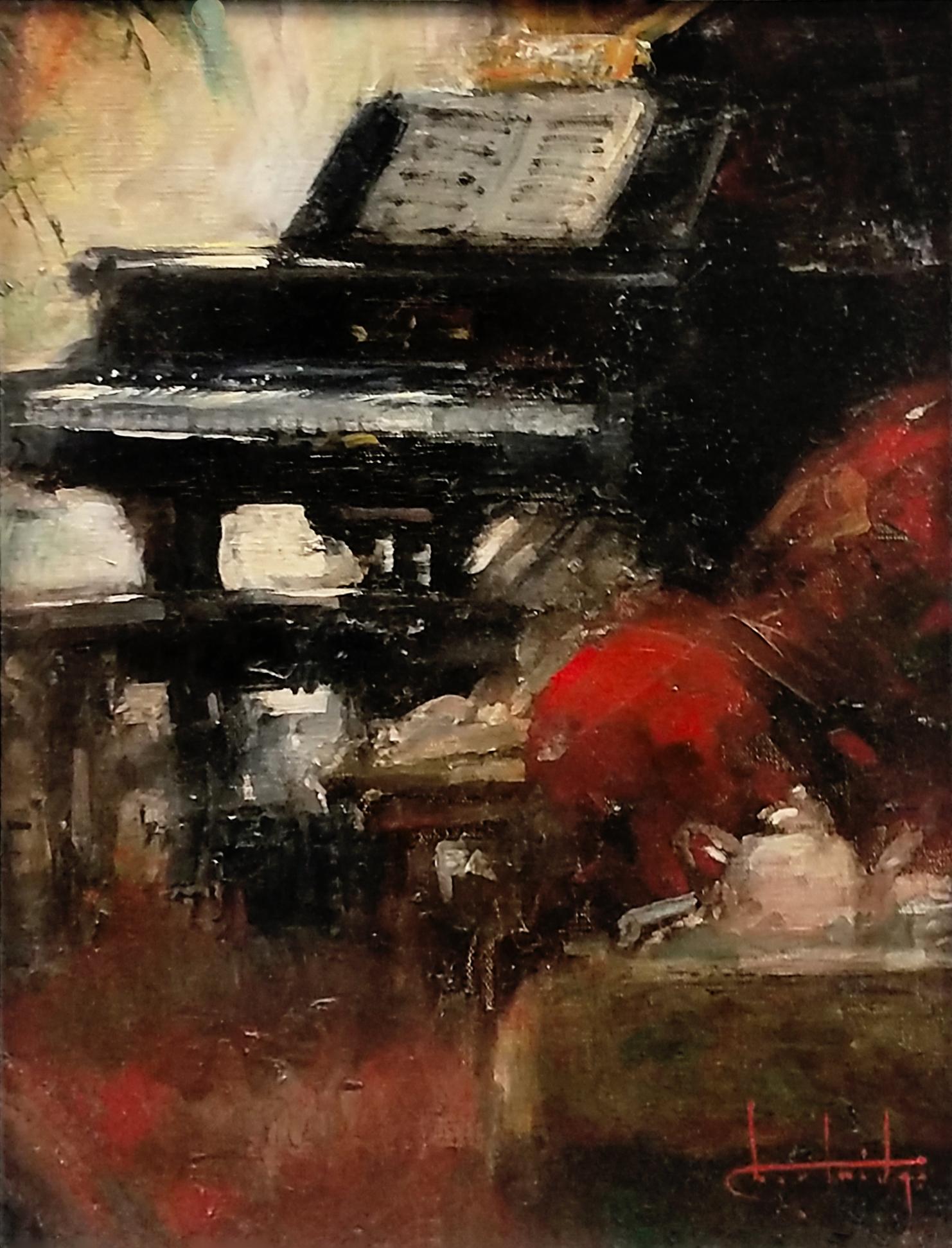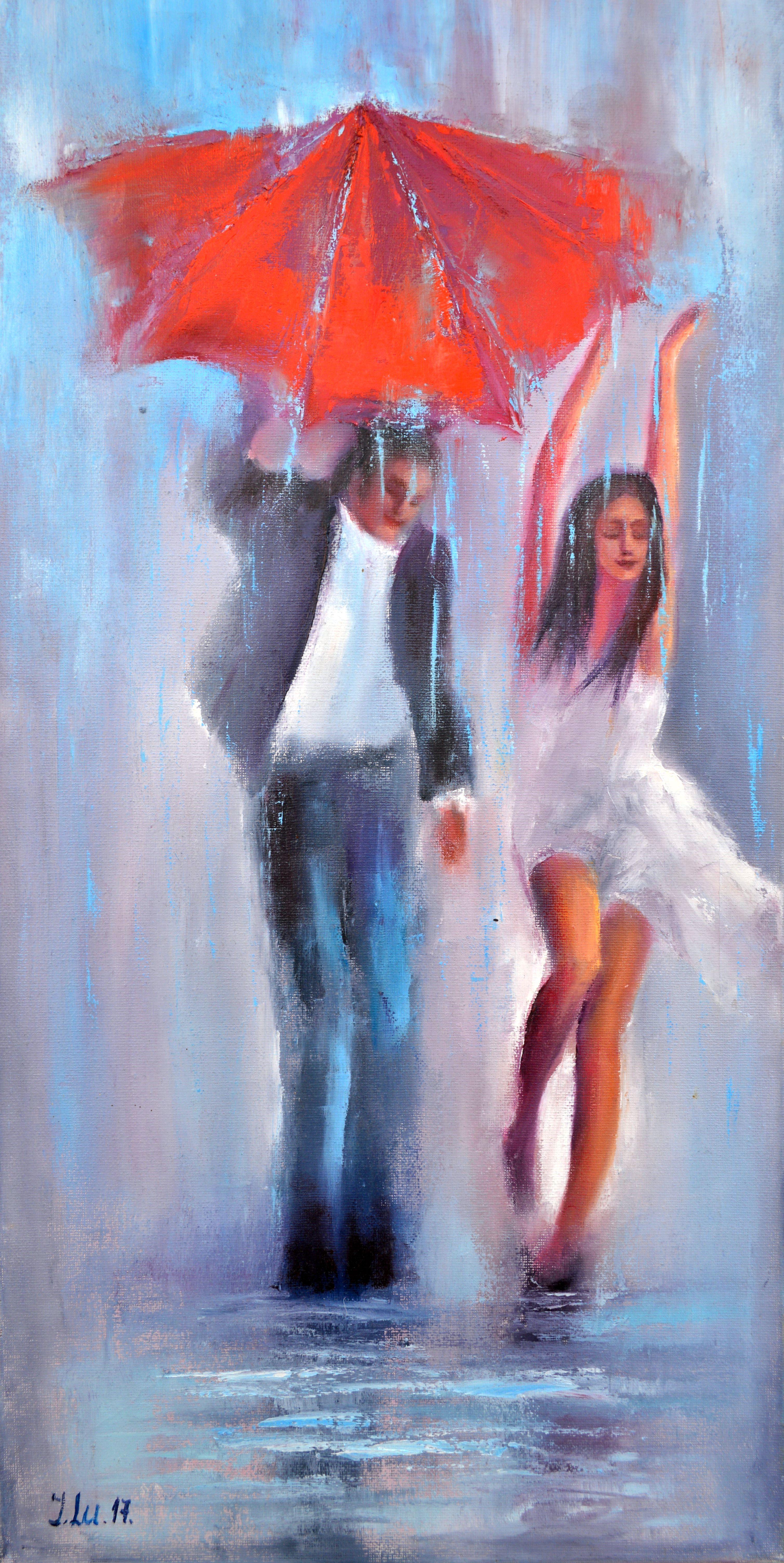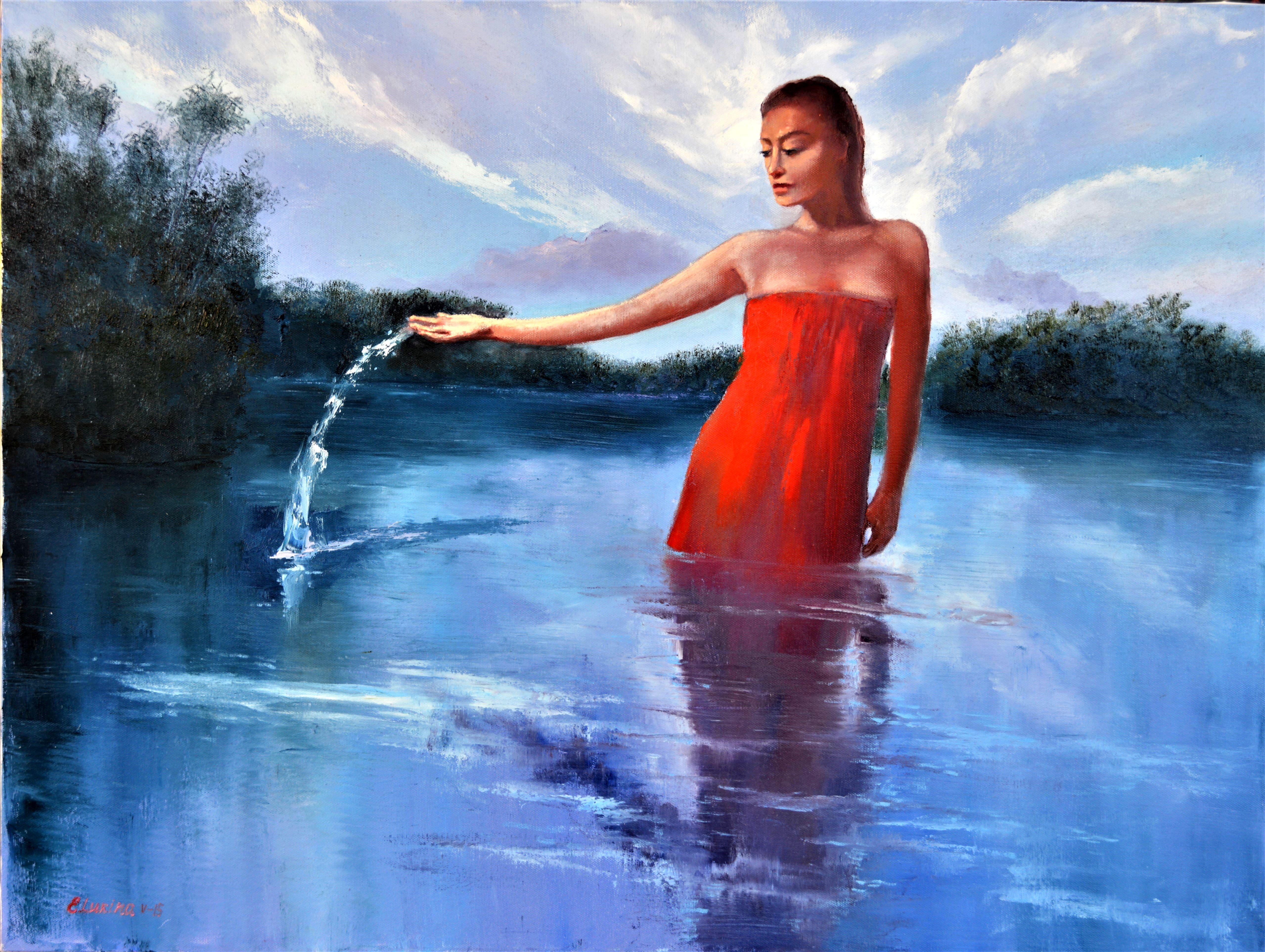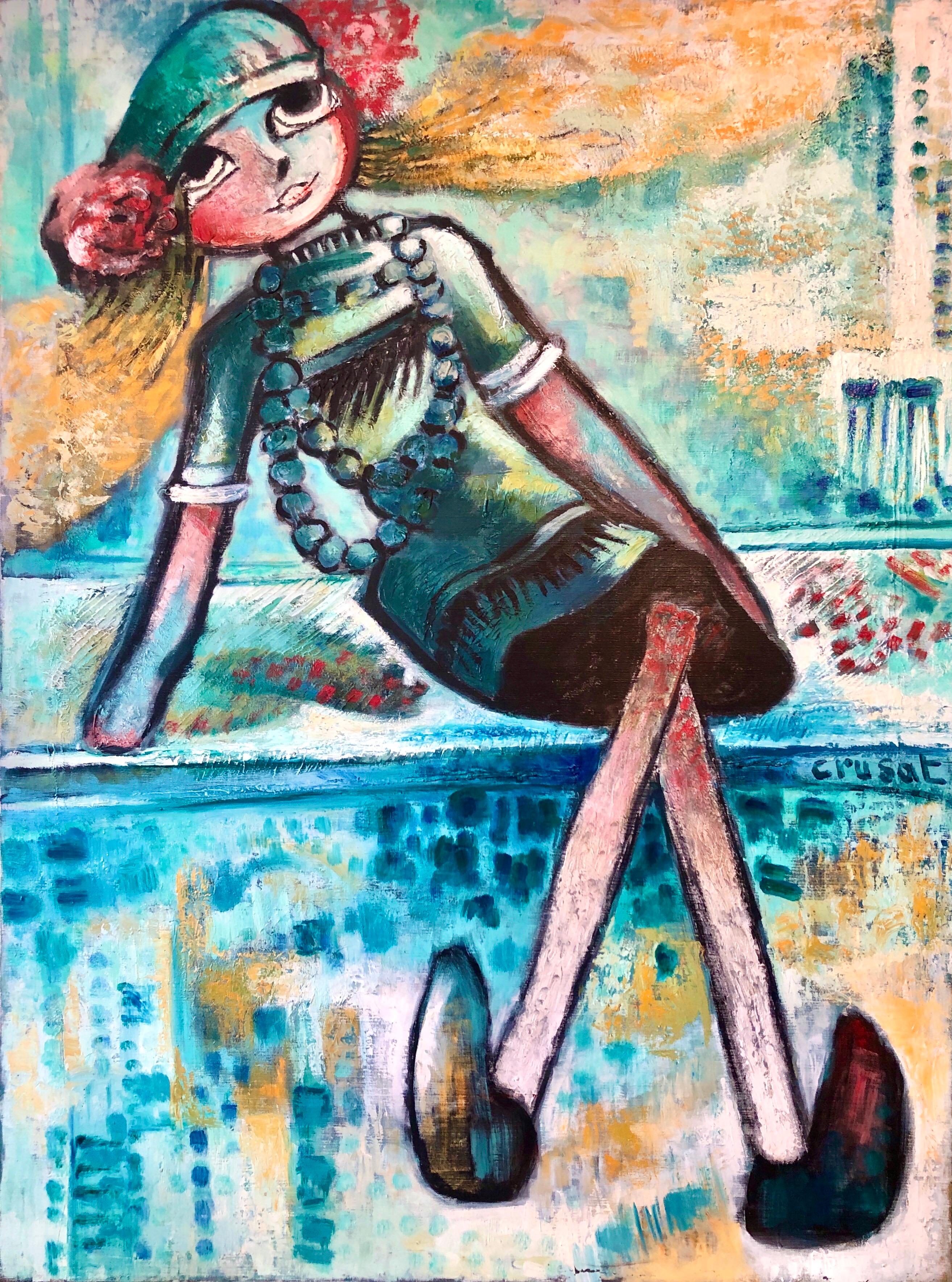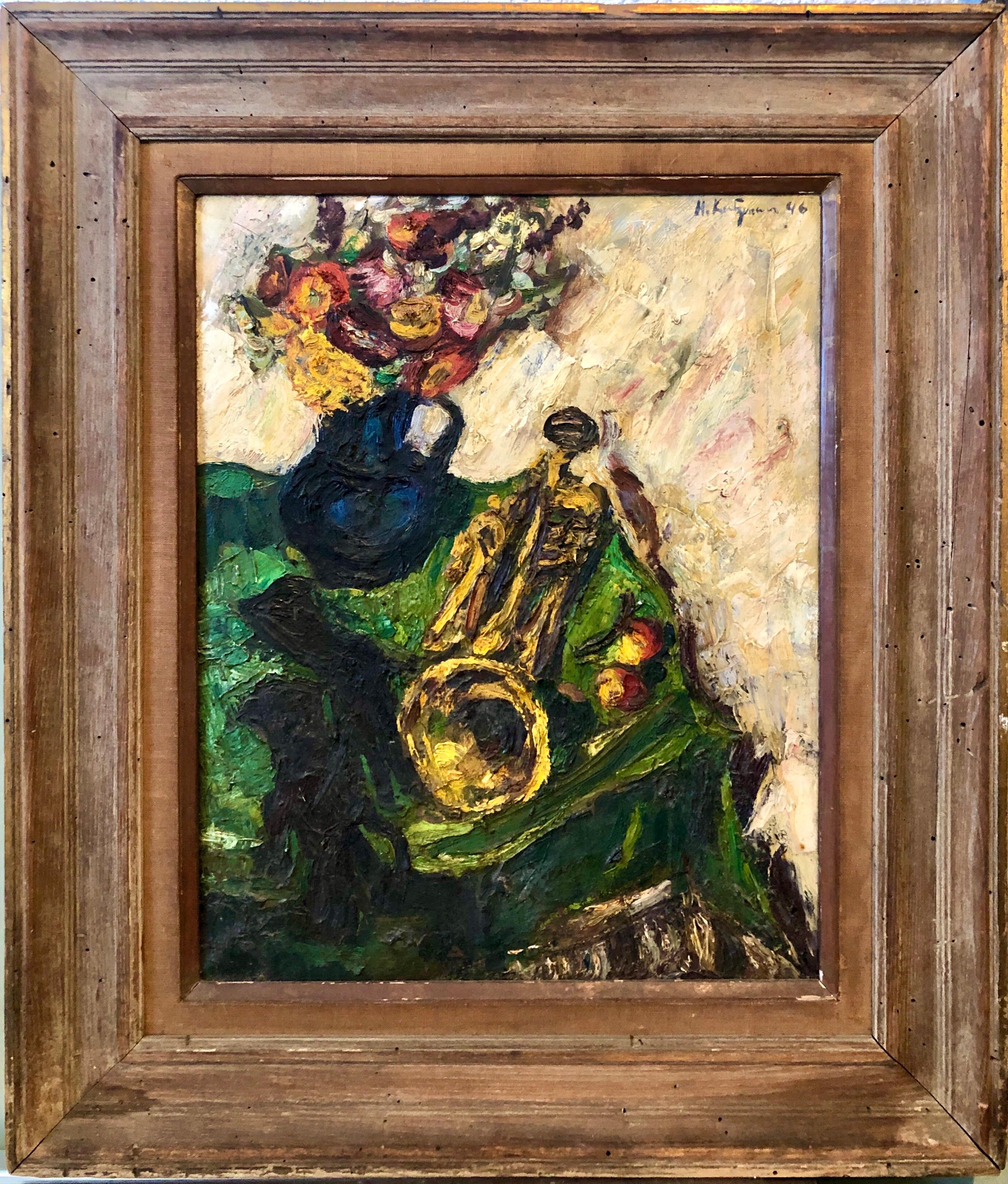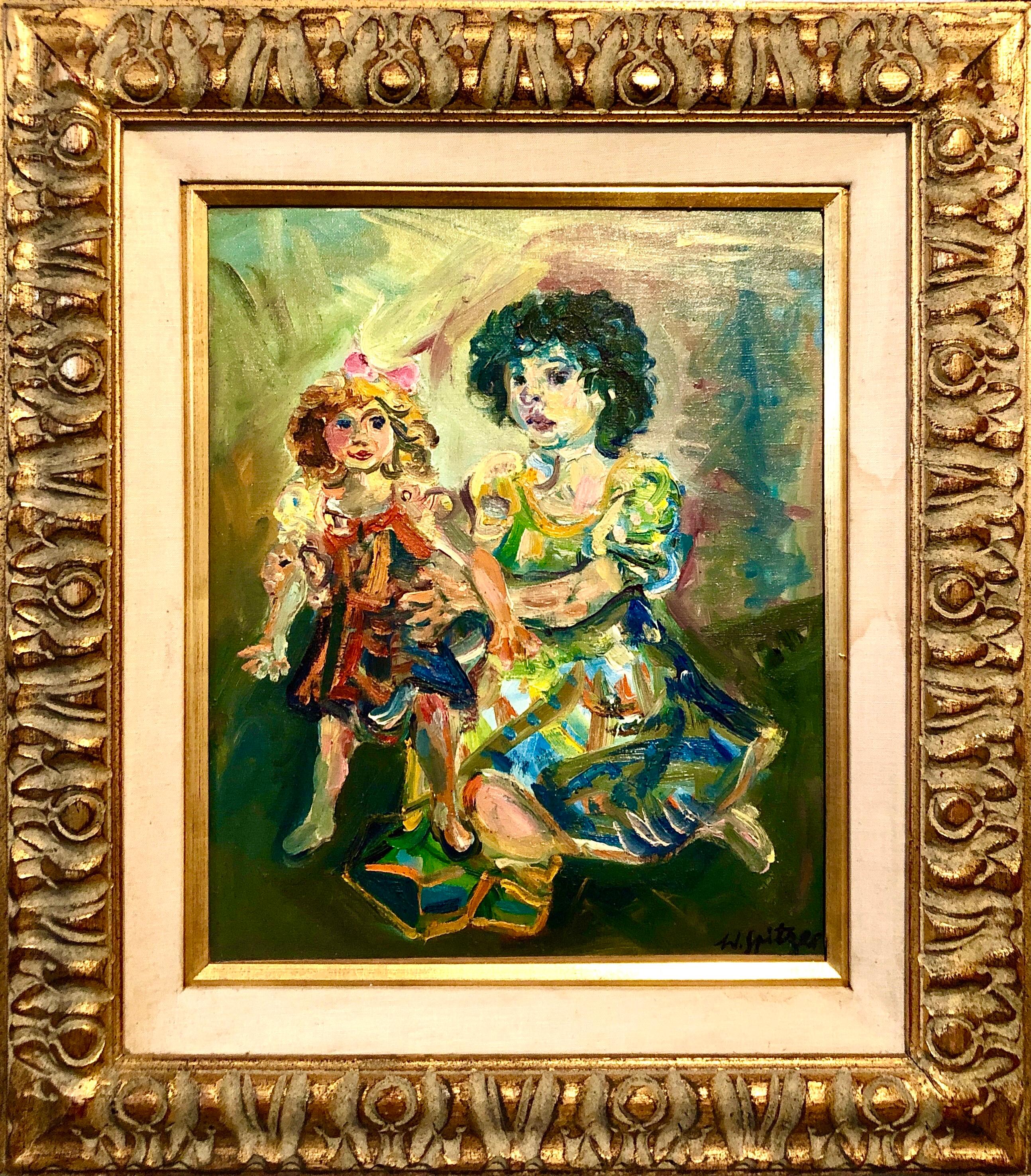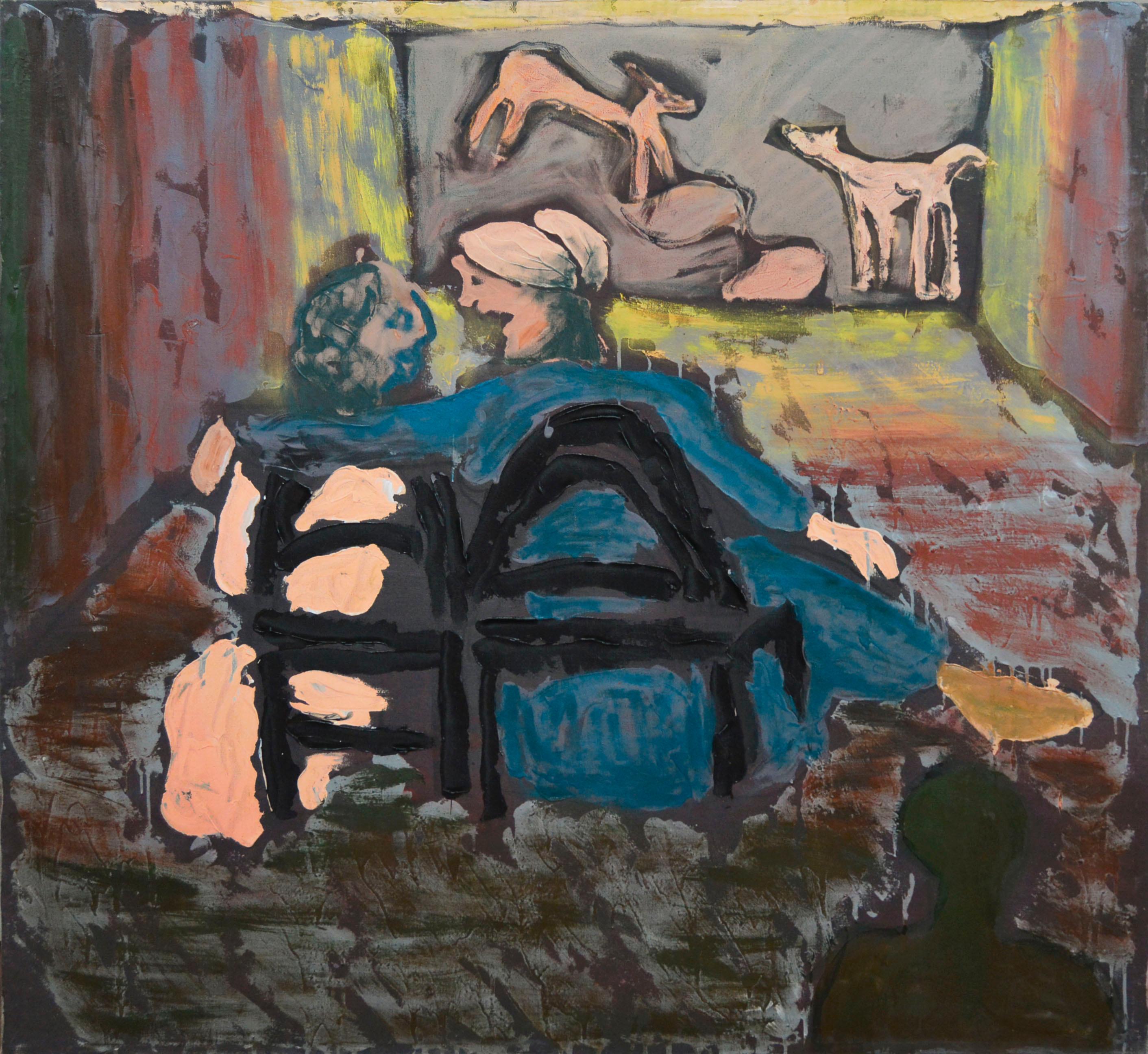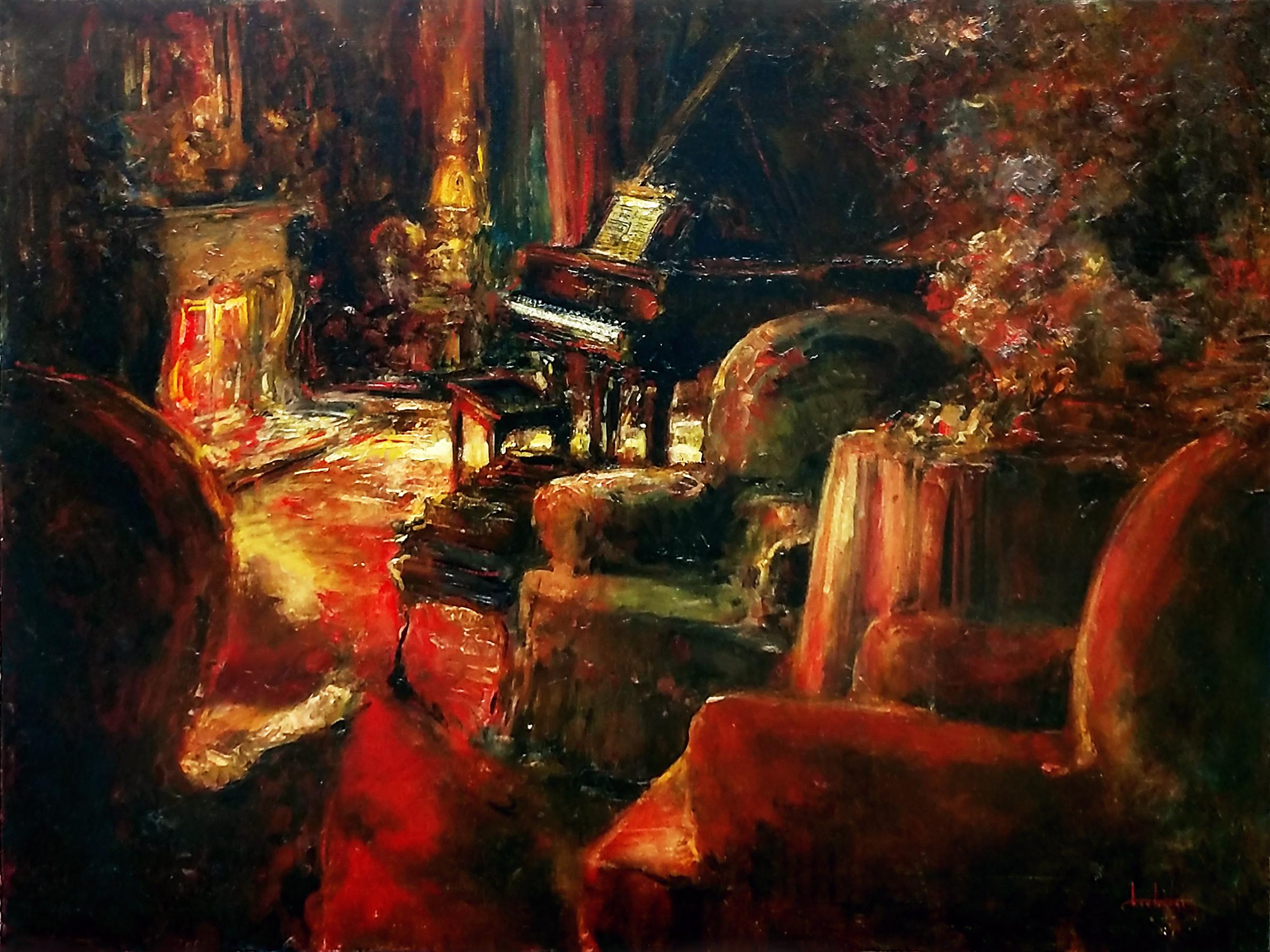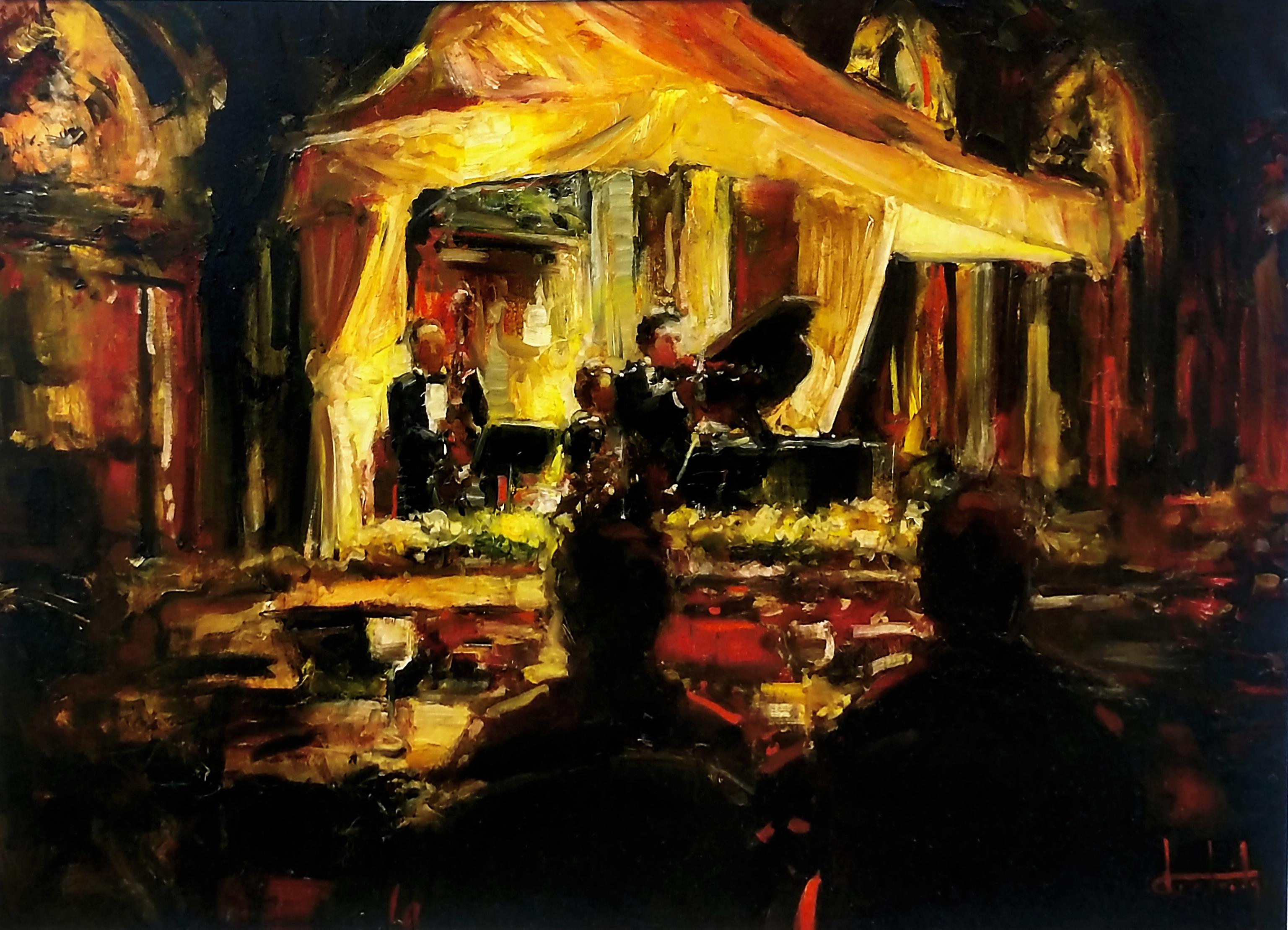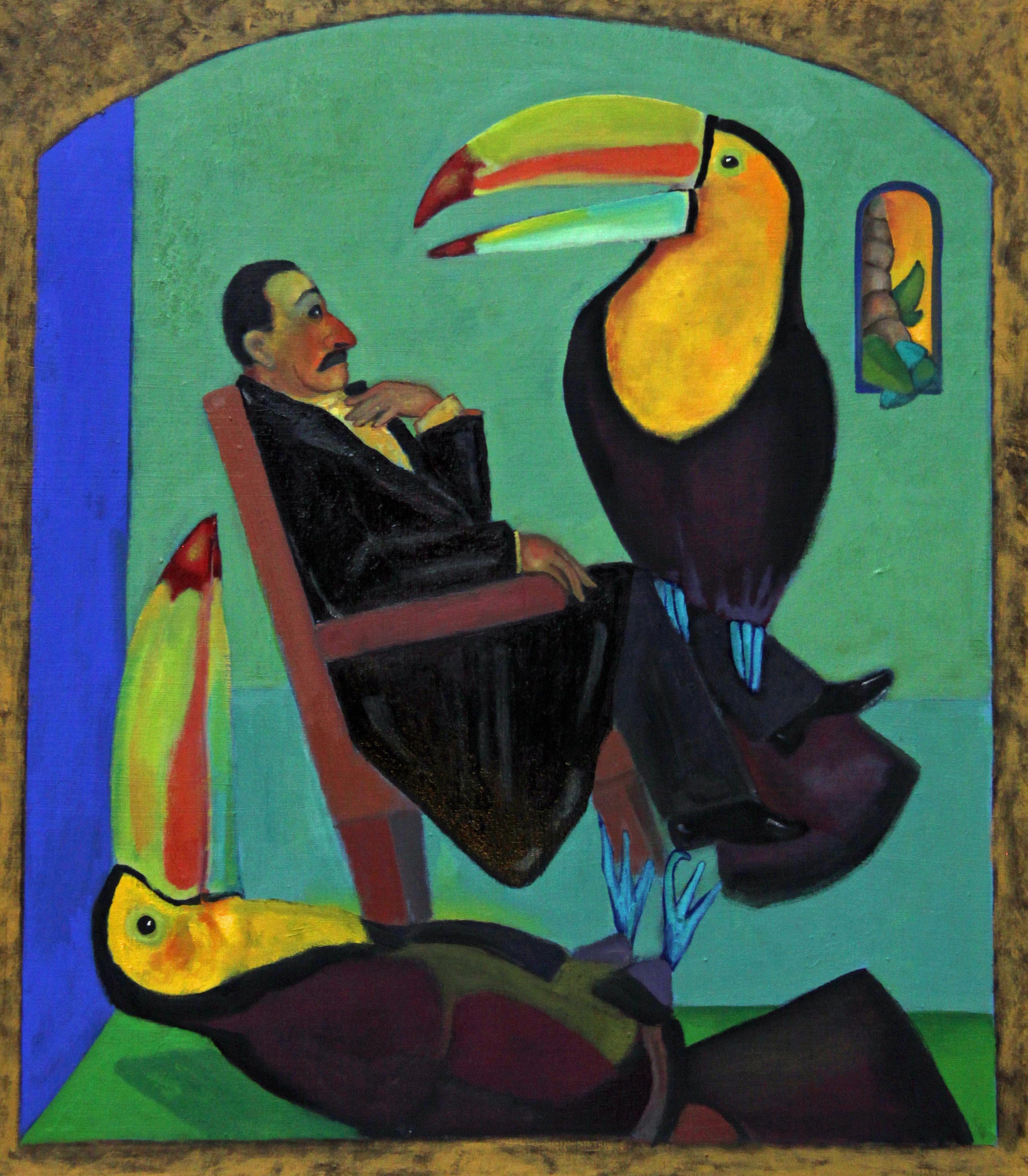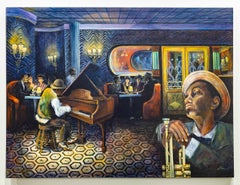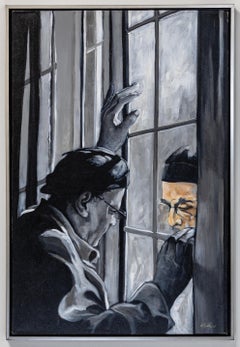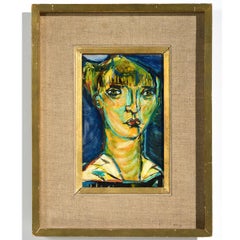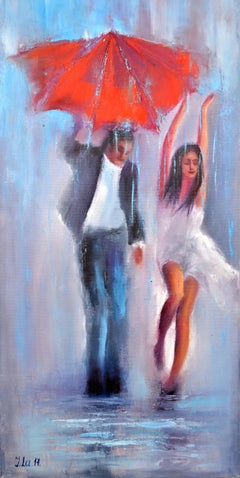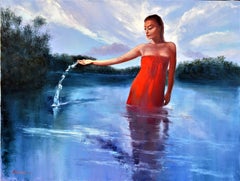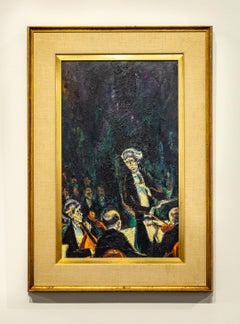
"The Conductor" Expressionist Oil Painting with Orchestra and Conductor
View Similar Items
Want more images or videos?
Request additional images or videos from the seller
1 of 11
Mervin Jules"The Conductor" Expressionist Oil Painting with Orchestra and Conductor1970 - 1980
1970 - 1980
About the Item
- Creator:Mervin Jules (1912 - 1994, American)
- Creation Year:1970 - 1980
- Dimensions:Height: 26 in (66.04 cm)Width: 18 in (45.72 cm)
- Medium:
- Movement & Style:
- Period:
- Condition:There is some age wear to frame and light staining on cloth mat.
- Gallery Location:Detroit, MI
- Reference Number:1stDibs: LU128615635561
About the Seller
5.0
Gold Seller
These expertly vetted sellers are highly rated and consistently exceed customer expectations.
Established in 2014
1stDibs seller since 2019
95 sales on 1stDibs
Typical response time: 3 hours
More From This SellerView All
- "The Weary Blues" Acrylic Painting of Interior w/Patrons and Music ColorfulBy Dennis K. SmithLocated in Detroit, MI"The Weary Blues" depicts the interior scene of a Blues bar late at night with a number of patrons socializing, drinking and listening to music. The scene is dramatically rendered in...Category
2010s Contemporary Figurative Paintings
MaterialsCanvas, Acrylic
- "I See Color" Figurative Acrylic on Canvas Looking Out Window Black White ColorBy Dennis K. SmithLocated in Detroit, MI"I See Color" is a dramatic psychological study of personal discovery painted in black and white with the face reflected on a window painted in color. Dennis states: It was a time wh...Category
Early 2000s Contemporary Figurative Paintings
MaterialsCanvas, Acrylic
- Michael Patrix Oil Painting "Head of Woman"Located in Detroit, MI"Head of Woman" is a wonderfully exciting example of Mid-20th century Expressionist art. This vibrant portrait is reminiscent of Matisse's Fauvist female...Category
Mid-20th Century Expressionist Figurative Paintings
MaterialsCanvas, Oil
- Fanny Rabel Figurative Oil Painting Soulful, PrayerfulBy Fanny RabelLocated in Detroit, MISALE ONE WEEK ONLY UNTITLED by Fanny Rabel a Mexican artist who was born in Poland in 1922 is a soul wrenching work depicting among other things, the children killed by Nazi bombing in Spain during the Second World War. The lavender and purple surrounding the seated female figure and the kneeling child suggest both grief for the innocents' deaths and the prayers being offered for an end to the carnage. The bright gold and red can be read as either explosions or the hopeful light of redemption after death. Like Picasso's Guernica from 1937, this painting from 1965 can stand as a powerful anti-war statement. Numerous key galleries and museums such as Morton Auctions, Cerro de Mayka have featured Fanny Rabel's work in the past. Her anti-Nazi and anti-Fascism politics resulted in her participation in a mural called Retrato de la Burguesía in 1940 for the Sindicato Mexicano de Electricistas building on Alfonso Caso Street in Mexico City. Rabel met a group of exiled Spaniards in Mexico along with Antonio Pujol, who invited her to take part in a mural project headed by him, David Alfaro Siqueiros, Joseph Renau, Luis Arenal, Antonio Rodríguez Luna and Miguel Prieto. The artist died in 2008. Fanny Rabel born August 27, 1922, in Poland born Fanny Rabinovich, was a Polish-born Mexican artist who is considered to be the first modern female muralist and one of the youngest associated with the Mexican muralism of the early to the mid-20th century. She and her family arrived in Mexico in 1938 from Europe and she studied art at the Escuela Nacional de Pintura, Escultura y Grabado "La Esmeralda", where she met and became friends with Frida Kahlo. She became the only female member of “Los Fridos” a group of students under Kahlo’s tutelage. She also worked as an assistant and apprentice to Diego Rivera and David Alfaro Siqueiros, painting several murals of her own during her career. The most significant of these is "Ronda en el tiempo" at the Museo Nacional de Antropología in Mexico City. She also created canvases and other works, with children often featured in her work, and was one of the first of her generation to work with ecological themes in a series of works begun in 1979. She is considered to be the first female muralist in Mexico. She was an assistant to Diego Rivera while he worked on the frescos for the National Palace and an apprentice to David Alfaro Siqueiros. Her most important mural is Ronda en el tiempo located in the Museo Nacional de Antropología, which was created from 1964 to 1965. She also created murals at the Unidad de Lavaderos Público de Tepalcatitlán (1945), Sobrevivencia, Alfabetización in Coyoacán in 1952 Sobrevivencia de un pueblo at the Centro Deportivo Israelita (1957) Hacia la salud for the Hospital Infantil de México (1982), La familia mexicana at the Registro Público de la Propiedad (1984) (which Rabel preferred to title Abolición de la propiedad privada) and at the Imprenta Artgraf. In collaboration with other artists, she participated in the creation of the murals at the La Rosita pulque bar (disappeared) and at the Casa de la Madre Soltera. She entered the Escuela Nacional de Pintura, Escultura y Grabado "La Esmeralda" shortly after it was established in 1942, taking classes with José Chávez Morado, Feliciano Peña and Frida Kahlo, with whom she became close friends. She changed her last name from Rabinovich to Rabel during her career. Rabel married urologist Jaime Woolrich and had two children Abel and Paloma Woolrich, both of whom became actors. The first exhibition of her work was in 1945 with twenty-four oils, thirteen drawings, and eight engravings at the Liga Popular Israelita with Frida Kahlo writing the presentation. In 1955, she had an individual exhibition at the Salón de la Plástica Mexicana. She had a large exhibition at the Museum of the Palacio de Bellas Artes to commemorate a half-century of her work. Her last exhibition was in 2007 at the Universidad Autónoma Metropolitana. Her work can be found in collections in over fifteen countries including those of the New York Public Library, the Library of Congress in Washington, D.C., the Royal Academy of Denmark, the National Library in Paris, the Casa de las Américas in Havana, the Benemérita Universidad Autónoma de Puebla and the Museo de Arte Moderno in Mexico City. A retrospective of her work after her death called Retrospectiva in Memoriam, Fanny Rabel (1922-2008) was held at the Museum of the Universidad Popular Autónoma del Estado de Puebla . She is considered to be the first modern female muralist in Mexico although she also did significant work in painting, engraving, drawing, and ceramic sculpture. Her work has been classified as poetic Surrealism, Neo-expressionism and is also considered part of the Escuela Mexicana de Pintura (the dominant art movement of the early to mid 20th century in Mexico) as one of the youngest muralists to be associated with it along with Arnold Belkin and José Hernández Delga. Rabel was more drawn to depicting mankind’s pain rather than happiness, sharing other Mexican muralists' concerns about social injustice. However, she stated to Leopoldo Méndez that she could not create combative works, with clenched fists and fierce faces, and she wanted to leave the Taller de Gráfica Popular. Méndez convinced her to stay, saying that more tender images are important to political struggle as well. Children with Mexican faces...Category
1960s Expressionist Figurative Paintings
MaterialsOil, Canvas
$21,000 Sale Price40% Off - "Untitled Female"By Richard WilsonLocated in Detroit, MI“Untitled Female" is a colorful piece by Richard Wilson that has meaning for native Detroiters through use of the blues and oranges - their "Tiger" baseball team's colors and the "D"...Category
2010s Expressionist Figurative Paintings
MaterialsCanvas, Acrylic
- Richard Wilson Figurative Female Iconic Detroit SymbolsBy Richard WilsonLocated in Detroit, MI“Untitled Female" is a colorful piece by Richard Wilson that has meaning for native Detroiters through use of the blues and oranges - their "Tiger" baseball team's colors and the "D"...Category
2010s Expressionist Figurative Paintings
MaterialsCanvas, Acrylic
You May Also Like
- Dancing in the rain 60X30 oil, Valentine’s Day gifts artLocated in Sempach, LUIn this vibrant oil painting, I've captured the essence of unbridled joy and carefree abandon. Two figures dance beneath a crimson umbrella, their movements a blend of expressionism ...Category
2010s Expressionist Interior Paintings
MaterialsOil, Canvas
- Red dress 60X80 oil, Valentine’s Day gifts artLocated in Sempach, LUIn this embodiment of passion and serenity, crafted with oil on canvas, my hand wove the essence of raw emotion into every stroke. I melded expressionism's vigor with realism's detai...Category
2010s Expressionist Figurative Paintings
MaterialsOil, Canvas
- Lady in Red 60X80 oil, Valentine’s Day gifts artLocated in Sempach, LUThis artwork is a passionate symphony in oil, where expressive strokes and vibrant hues of red capture the essence of emotion and movement. It blurs the lines between realism and exp...Category
2010s Expressionist Figurative Paintings
MaterialsOil, Canvas
- Large French Expressionist Oil Painting, Girl, Poupèe, the Doll, Ecole de ParisLocated in Surfside, FLSigned on recto and signed verso, titled, and inscribed Montmartre by the artist. This is a large colorful expressionist painting of a girl doll with long blonde or ginger redhead pigtails. It is titled Poupee 1925 and depicts an Art Deco era flapper girl in a beret. Roger Crusat (French Expressionist artist, poet and lithographer) is known for ballet troupe set design and theatre backdrop painting and architectural motifs. Roger Crusat was born in 1917 in Roussillon, Provence, France. Crusat's early works depict the colorful countryside of Provence in the South of France, As a young man Crusat performed many jobs in the troupe, designing costumes, and even dancing. But, most important, he painted the scenery for the troupe's performances. It was while working in this capacity that he learned the essentials of scenery painting that remain evident in his mature work. Crusat was a student of Andre Fons-Godail at Beaux-Arts in Perpignan when he was called to serve in World War II. After being wounded in 1940, he returned to study under Rene Jaudon at Beaux-Arts in Paris. Crusat was known by his contemporaries as "the Catalan painter of Montmartre" where he lived with his wife until his death in 1994. Cracked and peeling walls framed by rusting water pipes are a common sight in Montmartre. What others considered unnecessary, Crusat included. Water pipes were his cherished motif. Supposed by some to be a symbol of decay and monotony, Crusat's Impressionist water pipes like arteries in the body, convey life. Crusat won the prestigious Prix Populiste for his "Descente d'Eau" (Water Pipes) in 1956. Crusat's mature work retains the essentials of good scenery painting. Intricate detail will not be found, but broad, solid abstract shapes abound. His subtle colors, dense in texture, are meant to compliment his subjects, not distract from them. The critics considered him a lyric expressionist and a "painter of Man" in his portrayal of the anguish of daily life and the regrets of the past. Crusat exhibited at many of the same Salons as the post-impressionists and expressionists. Salon des Independants was co-founded by Georges Seurat. Degas had only one exhibition during his lifetime, and it was at the Galerie Durand Ruel in Paris. Gauguin had also exhibited his Tahitian paintings. Crusat's works were exhibited there in 1955. SELECT AWARDS 1954 Le Prix de la Jeune Peintre 1955 Prix des Amateurs d'Art & des Collectionneurs, Galerie Gazette des Beaux Arts, 140 rue Faubourg St. Honore, Paris Les Jardins des Abbesses purchased by the Republic of France, Prix de la Ville de Marseilles, Prix Othon Friesz 1956 Prix Populiste, Prix de Amedeo Modigliani 1957 Grand Prix International de Vichy, Prix de la Fondation Greenshields 1959 IVeme Grand Prix de Peinture du Festival de Vichy 1967 Le Prix des Amis de Brantôme, Perigord, France 1970 Prix de la Critique Academy de Vernet a Vichy,"La Nuit, Premiere Etude" Roger Crusat, Half-closed shutters , poems enriched with four original lithographs (175 numbered copies) drawn on Henri Deprest's presses on February 13, 1975 , Éditions Matignon 34, 1975. Personal exhibitions Durand-Ruel Gallery, Paris, 1955 [ 1 ] . Galerie Rivière, Paris, november 1958 [ 4 ] . Le Roux and Mathias, auctioneers in Paris, Sale of the Roger Crusat workshop , Hôtel Drouot , Paris, Thursday October 27, 1994 [ 5 ] . Jack's American Bistro, Glens Falls , September- october 2004 [ 6 ] . Collective exhibitions Galerie Roger, Lyon , October 1946 [ 7 ] . Salon des Indépendants , Paris, from 1952 [ 8 ] . Exhibition Discover , Galerie Charpentier , Paris, 1955. Populist Salon, Paris, 1956. Salon des Amis de Brantôme, 1957. Hundred painters and oil - Exhibition on the occasion of the centenary of the first oil drilling , Musée Galliera , october 1958 [ 9 ] . “An artist from Roussillon whose invoice calls for a flattering comparison with that of a Soutine or a Rebeyrolle . Indeed, following their example, he focuses on familiar scenes: Girls on the balcony or in the basket , Laundresses weighing heavily on the iron, draft horses or plucked turkeys, who stand next to a magnificent portrait of a man in a red dressing gown . Hasn't the Prix Populiste already crowned its merits? " - Jean Jacquinot SELECT EXHIBITIONS Galerie La Gentilhommiere, Paris La Salle Arago, Perpignan, Salon des Indépendants, Salon d'Automne Biennale de Menton, Menton Galerie des Jacobins, Lyon Galerie Durand-Ruel, Paris Salon de la Nationale Galerie Bassano, Paris Salon Populiste Salon de Romans Galerie Motte, Geneva, Switzerland Exposition à Quiberville sur Mer - Normandie Galerie Charpentier Salon Confrontation: Bernard Buffet, Roger Crusat, Jean Jansem, Franck Innocent, Jean-Jacques Morvan...Category
Mid-20th Century Expressionist Figurative Paintings
MaterialsCanvas, Oil
- 1950's Expressionist Interior Oil Painting Still Life with Flowers and TrumpetBy Herbert KatzmanLocated in Surfside, FLHerbert Katzman 1923-2004 (American artist active in New york, Illinois and Italy) Oil Painting Dated 1946. Signed. Dimensions; Sight-16" x 20", Frame-23.5" x 27". Provenance: this bears an old stamp verso from Christie's auction house. Herbert Katzman was born in Chicago on Jan. 8, 1923, His father believing that discipline was a good teacher, sent Herbert and Bob to St. John's military academy for their elementary education but it wasn't long before Herbert found his way to the Art Institute of Chicago where he wanted to study sculpting. His Father vehemently objected and refused to finance his studies, but that wasn't enough to discourage the young artist. He put himself through school working as a student janitor and a few other odd jobs. At 17 he entered the Advanced School of the Art Institute, his interest having turned to painting. His study there was briefly interrupted by a short stint in the navy (1942-44). After receiving a medical discharge, he returned to Chicago to work with Boris Anisfeld, who introduced him to German and French Expressionism...Category
Mid-20th Century Expressionist Figurative Paintings
MaterialsOil, Canvas
- Polish French Jewish Artist Oil Painting Girl with Doll, School of Paris JudaicaBy Walter SpitzerLocated in Surfside, FLFramed 27 X 24 inches Sight 18 X 15 inches Walter Spitzer (Polish/French, 1927 - ) born in Cieszyn, Poland. A Polish Jewish Holocaust survivor, he made his first drawings in a concentration camp. Walter Spitzer has lived and worked since WWII in France, where he studied at the École des Beaux Arts in Paris. Walter Spitzer has achieved great renown as a painter and printmaker. Whether in his paintings of Biblical subjects or in lithographs of Shtetl scenes, His humanity was inspired by the writings of Sartre, Montherlant and Kazantzakis, Walter Spitzer is occupied with two great, interlinked themes: man’s inhumanity to man, and the humanity of man. He will surely be recognized in the future as one of the great witnesses to the twentieth-century experience. Walter Spitzer was born in Chieszyn, Poland, the son of a Jewish liqueur producer, and attended the German school there. He began to draw and paint at an early age. In 1939 the Spitzer family was forcibly removed by the Germans to the town of Strzemieszyce, which was turned into a ghetto in 1942. When the ghetto was liquidated in June 1943 Spitzer’s mother was shot, and the sixteen-year-old Walter was deported to Blechhammer, a subcamp of Auschwitz. There he painted portraits of Wehrmacht soldiers and fellow inmates in exchange for food. He was one of the few to survive the evacuation march from Auschwitz to Buchenwald, where to begin with, in late February 1945, he was held in the Little Camp. To enable him to make drawings documenting life in the camp, the Communists organized his transfer to the main camp. While on a death march in early April he made his escape in the vicinity of Jena and was soon in the hands of the Americans. Spitzer served as an interpreter with an American army unit, and at the same time executed numerous drawings depicting the world of the camps. In June 1945 the Americans took him to Paris, where – following the advice of his father, who had died in 1940 – he began to study art at the École des Beaux-Arts in Par the following year. After completing his training as an artist he produced paintings expressing a critical view of the society of his day. In 1955, in commemoration of the camps and the death marches, he executed a cycle of nine etchings in an edition of thirty, which he gave to various museums in Israel and in France. In the 1960s he established himself as an illustrator of exclusive editions of works by such authors as André Malraux, Jean-Paul Sartre, Joseph Kessel and Nikos Kazantzakis. The Six-Day War prompted him to begin painting subjects from Jewish and Biblical history; At age 19, he was asked to make the scenery for the Edouard VII Theater in Paris, which was showing The Dibbuk of Ansky. In 1947 the same theater asked him to make the scenery for the Hill of Life ( Max Zveig). Spitzer has been a member of the Salon d'Automne since 1952. He was the last remaining survivor of the Montparnasse Ecole de Paris. A group of Jewish expats that included Issachar Ber Ryback, Abel Pann, Abraham Mintchine, Isaac Antcher, Alexandre Altmann, Henri Epstein, Mane Katz, Marcel Janco, Gregoire Michonze...Category
1960s Expressionist Figurative Paintings
MaterialsCanvas, Oil
Recently Viewed
View AllMore Ways To Browse
Box Seat
Early Massachusetts Paintings
Genuine Oil Paintings
Provincetown Paintings
Maryland Oil Painting
The Orchestra
Orchestra Art
The Conductor
Hart Oil Paintings
Orchestra Paintings
Oil Paintings By Hart
Orchestra Vintage
Honore Daumier
Thomas Hart Benton Signed
Daumier Artist
Musical Box Vintage
Conductor Painting
Bird Eye Box
